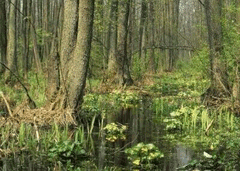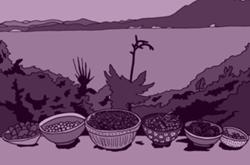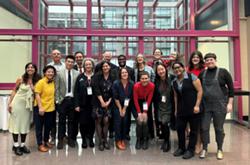
British Columbians could soon buy and trade certified carbon credits as part of a continental carbon market, according to an announcement made last week by Premier Gordon Campbell. And from cooking up mine tailings to seeding the oceans with iron, it seems there will be no shortage of proposed carbon-offset schemes for eager greens to buy into.
But as one Haida village is finding out, planting a carbon credit farm is no easy feat. Scientists, activists and businessmen don't all agree on the net environmental impact of some projects, or even on how much carbon they can offset.
Carbon Sinks in Haida Gwaii
John Disney is the economic development officer for Old Massett, a Haida village of about 700 on the eastern shore of Masset Inlet. Disney thinks there is money to be made and carbon to be sequestered by cutting the alder out of the long-ago logged riverbanks in the region and replanting the area with conifers. He just needs $4.5 million and access to protected buffer areas on the banks of two rivers to prove it.
At its most simple the idea goes like this. Trees absorb carbon from the atmosphere and store it as wood. Big trees store more carbon than little ones and coniferous trees sequester more carbon than alders, especially given their longer lifespan.
Disney figures he can help areas along the riverbanks of Haida Gwaii suck more carbon by replacing the alder that has grown up since the old growth was logged decades ago. If funded, the project would also provide hundreds of days of well-paid employment for the under-employed community of Old Masset.
But, as Disney is finding out, nothing is that simple, especially not carbon credits.
Disney and his partners at Raincoast Carbon Restorations have identified 100 kilometres of river-sides along two important fish-bearing streams on the islands for a proposed pilot project. But because they want to do the work on Crown land, Disney first needs permission from the provincial government. The land also falls within riparian zones, which are protected under provincial legislation to within 50 to 100 metres of the water's edge.
Red alder is the coastal rainforest's natural band-aid. The species grows quickly after a disturbance, be it clear cut, flood or landslide. Conifers reseed and grow in these patches until the shorter-lived alder dies back and conifers once again take over. In the meantime alder plays an important role in maintaining soil stability, especially along the banks of fish-bearing streams.
As a result, the B.C. Forest Service is cautious about Disney's plans. The service had four comprehensive reviews done of Disney's project and some large questions were raised, such as whether cutting alder to plant conifers will actually benefit the riparian areas, and, if this benefit will come any sooner than it is taking these areas to naturally regenerate.
Peter Tschaplinski, a manager in the research branch of the Ministry of Forests, wrote in his review of the Haida Climate Forest Project that the proposal overestimates how effective similar projects have been. "The authors [of the pilot project proposal] may be unaware," he wrote, "that the outcomes of tens of millions of dollars worth of riparian and stream channel restoration projects conducted under [Forest Renewal B.C.'s Watershed Restoration Program] have never been properly evaluated."
Not only have many of these projects not been evaluated, but others had disastrous results. He goes on to say: "In spite of good intentions, there are numerous examples of WRP-funded projects where substantial amount of damage was inadvertently done to riparian areas.... "
'Credible science'
Others question whether the scheme can produce the net carbon offsets it claims.
"You can't sell this kind of thing unless you've got credible science behind it," says Gary Bull, a professor in the Forestry faculty at the University of British Columbia. Bull commends the vision of the Haida Climate Forest Project, but warns that the proposal falls short of demonstrating its viability. He says soaking carbon out of the atmosphere with riparian restoration projects is a good idea, but the proposal needs to follow an accepted methodology.
Bull suggests the proponents look toward the emerging international standards for carbon sequestration projects of bodies like the United Nations Framework Convention on Climate Change.
He also points out that while Canadian forests soak up carbon they release it as well and both of these factors have to be taken into account before carbon forest projects can be taken seriously. Forests are a polluter, he says, noting forest fires, are one major source. "But they also have the potential to solve part of the problem through sequestration."
Others have pointed out there has been no accounting of the amount of carbon that will be produced in getting this project underway. How many trucks will go up and down the logging roads, how many times, to do the work?
Ownership questioned
Another stumbling block for the Haida Gwaii Climate Forest Project is the question of who owns carbon credits and who should benefit from the sale of them.
The federal government has, in the past, declared that as the signatory of the Kyoto Protocol, they own any forest carbon sinks. The province hasn't come up with any policy on the question.
Bull thinks the Haida Gwaii project is great in this aspect, if only because it pushes the agenda. In New Zealand the government tried to claim they owned all the carbon credits and the landowners went ballistic, he says. The government eventually backed down. But in Canada, "No one seems to care right now."
One of the biggest concerns about not just this project, but any carbon credit scheme, comes down to a philosophical issue. Some think selling companies the right to continue polluting is immoral and is the wrong approach on climate change.
But that's poppycock according to people like Joseph Pallant from ERA Ecosystem Restoration Associates, a private company with a project similar to Disney's in the Lower Mainland. Pallant says ensuring the science for any carbon credit project is sound is essential, but he doesn't have time for those who balk at the thought of selling credits in the first place.
ERA plants conifers on the banks of ravines and rivers in Maple Ridge. Like the Haida Gwai proposal, the company removes alder, or plants in existing openings, but there are a few key differences between the projects. Most significantly, the urban land is owned by the municipality and, as Pallant describes, has been so altered that there are no nearby conifers for any natural re-seeding to take place. The municipality gives ERA the right to the carbon credits in exchange for free restoration of green spaces in Maple Ridge.
In this case, Pallant and associates appear to have a winning project. They have done the science, set the baselines, modeled the carbon and had it all validated and verified through the rigorous international greenhouse gas standard known as ISO 14064-2, under which carbon sequestration must be scientifically verifiable and additional (meaning carbon wouldn't be soaked up anyway, if the project were not done.)
Pallant says the trees planted so far are conservatively projected to sequester 200,000 tonnes of carbon dioxide equivalent over the next 80 years. Anyone can offset 10 tonnes emitted from their SUV every year by paying ERA $100 and help keep this project rolling. ERA estimates they will sequester 2,300,000 tonnes when the project in Maple Ridge has been fully planted.
But even ERA, which has planted 25,000 trees in Maple Ridge since 2005, will not show any net carbon sequestration for several years while the little conifers are getting established.
That's a small point, says Pallant, who believes the climate change situation is so dire, that we are so close to the tipping point where shifts may occur that will make it impossible for life as we know it to continue, that it is irresponsible not to support carbon credit projects. "All good actions should be applauded and supported," he says.
The jury is still out on carbon credit projects like Disney's, but he and his partners may wish to heed the words of another of the forestry expert, UBC professor Dr. Hamish Kimmins, who reviewed his project:
"Carbon storage is the current 'flavour of the month' but this will change," he wrote. "The Kyoto accord will evolve to recognize that forests have a finite ability to store carbon, and when this is fully utilized, forests are no longer a useful way of removing atmospheric C."
Related Tyee stories:














Tyee Commenting Guidelines
Comments that violate guidelines risk being deleted, and violations may result in a temporary or permanent user ban. Maintain the spirit of good conversation to stay in the discussion.
*Please note The Tyee is not a forum for spreading misinformation about COVID-19, denying its existence or minimizing its risk to public health.
Do:
Do not: